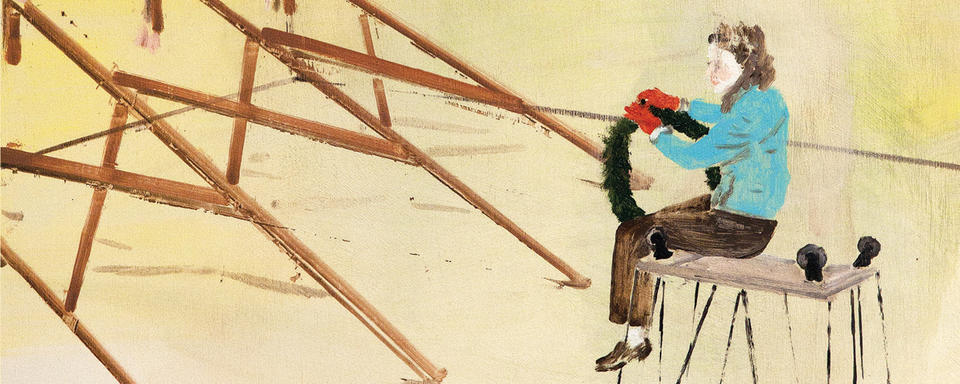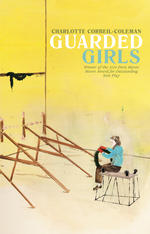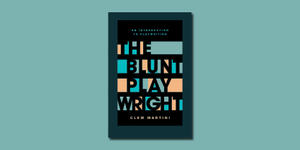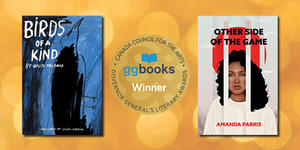
Trapped in the cycles of the system
An interview with Charlotte Corbeil-Coleman on Guarded Girls
“It’s easy not to look at our prison system,” Charlotte Corbeil-Coleman wrote in her preface to her newest play, Guarded Girls. “Looking at it means engaging with a lot of hard questions about our society and ourselves.”
But Corbeil-Coleman did just that in order to create the play, which intertwines the stories of three imprisoned women, a guard, and three girls who are in one way or another trapped by the system. There’s nineteen-year-old Sid, who is transferred to a new prison and finds friendship with her cellmate Brit and a complicated relationship with a guard. There’s Kit, who talks to an unseen audience about a coming visitor and how she’ll stop at nothing to see them. And then there are the three girls who wait as visitors, each one thinking about the complicated positions their mothers are in. Each story shows a different piece of the unjust treatment of women in the Canadian prison system, and yet still gives us heart and humour.
In this interview, Charlotte discusses how she came to this play, the kind of research that went into it, her writing process, the importance of cycles, and more.
What prompted you to write about the Canadian correctional system? How much did you know about it before you started working on the play?
Matt White from Green Light Arts, a great theatre company based in the Kitchener, Waterloo, area, approached me about writing a play about Ashley Smith, a teenager who died while under suicide watch at the Grand Valley Institution for Women. Ashley first entered the correctional system when she was thirteen for throwing crabapples at a mailman and she never left the system. Her death was ultimately ruled a homicide as the guards watched her kill herself without intervening. As I researched Ashley’s story, my eyes were opened to a lot of stories of injustice within our correctional systems. I decided I wanted to write a story about many different imaginary women that was grounded in the research and interviews I did.
I didn’t know much about Correctional Service Canada before writing my play. Mostly what I knew about the prison system came from what I’d seen on TV and it was mostly about the American system.
What kinds of research did you conduct for the play? What was something that really stood out to you?
I read a lot of articles by excellent journalists who have tried to bring attention to our prison system. I read and listened to interviews by women in prison. I personally interviewed and listened to women who had recently been incarcerated.
I was disturbed that some of the most vulnerable people in our society end up incarcerated. I was surprised by how easy it is to get into the corrections system and how hard it is to get out. I started to picture what society deems as “acceptable” and “unacceptable” as an imaginary line. I could easily have ended up in prison, but my race, privilege, and support systems protected me. This protection allowed my addictions, mental health issues, and trauma to all fall on the right side of the line.
Each character in Guarded Girls is so strong, that even right from the beginning we see two characters playing a game where they pretend to be each other, and we can easily follow along. Could you speak about what it takes to develop a strong character, and what you wanted to instil in them?
I loved my characters for all their fear, anger, and vulnerabilities, just like I love the real people in my life for all these things. I think the act of loving someone is an attempt at trying to really know them. The game “you be me” lets the characters escape from their own experience but it also lets them to inhabit another person's experience. This attempt to “be” another person is a form of love. They get to play the game I played while writing them.
What was the writing process like for you?
Writing Guarded Girls was like nothing I had ever written before; it just came pouring out of me. I wrote it in three different parts in three different documents and I had no idea how they all connected until I suddenly did. It was the most mysterious thing I’ve ever created. I had to trust the voices I was hearing and let them guide me through their story. I really discovered it as I was creating it. It was spooky! It was also an unusual process because every morning I was so excited to get up and write, no procrastination, which really is strange.
You’ve spoken about how you wanted to incorporate cycles into the play—can you expand on this? Why was it important, what types of cycles, and how did you develop it through the play?
It is so hard to break a cycle, in ourselves, in our institutions, and in our society. It is very easy to get stuck doing the same thing again and again, especially if we don’t have the support and space to do the work that is needed for healing. My play is about trauma being passed down from generation to generation and how trauma will keep repeating if it is not healed.
The guard in my play is traumatized by an inmate holding her hostage. This inmate is traumatized by the death of her mother and the systems that failed her. The guard does not deal with her PTSD and because of this goes on to traumatize another inmate. The three girls, in part three of my play, are trying to understand their relationships with their mothers and ultimately trying to break the cycles of trauma they inherited from them.
My mother died when I was a teenager. To survive this pain, I did a lot of unhealthy things. To try and heal I had to deal with my grief, and I had to also deal with all the unhealthy ways I used to suppress this grief. The cycle of pain, the thing you do to not feel pain, and that thing becoming a new pain is a very hard cycle to break. This is the cycle Kit finds herself in.
What do you want people to take away from this play?
Compassion, understanding, and productive outrage. I want them to see how under a different set of circumstances, they could find themselves in many of these women’s shoes. I also want them to seriously question our correctional system, especially its use of solitary confinement.
What are you up to next?
I’ve been writing a musical! I’m also working on a feature film called The Matchless Six. It’s set in 1928, the first year that the Olympics let women into track and field. Canada sent six incredible women to compete and they dominated, winning the overall gold for Canada.
Need to know what happens in the play? Get your copy of Guarded Girls now!



Comments